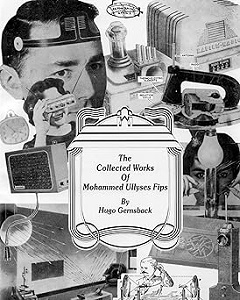|
April 1961 Radio-Electronics
 [Table of Contents] [Table of Contents]
Wax nostalgic about and learn from the history of early electronics.
See articles from Radio-Electronics,
published 1930-1988. All copyrights hereby acknowledged.
|
I don't know where the
name Mohammed Ulysses Fips came from, but it is the pseudonym chosen by editor
Hugo Gernsback. The first and middle names are easy enough to ascertain an
origin. According to the
iGENEA website: "The last name Fips is most commonly found in the
Netherlands, as well as in other parts of Europe. The surname originated in the
Netherlands, likely from personal names or nicknames related to the word "vips"
("expensive" or "luxurious"). The earliest recorded Fips dates back to 1490 in
the Netherlands." Hugo Gernsback was born in 1884 in
Luxembourg City (Luxembourg),
separated only by Belguim from the Netherlands, so maybe that is where he came
up with it. For some reason, the articles written by Mohammed Ulysses Fips,
purportedly a member of the Islamic Radio Engineers (I.R.E), always appeared in
April issues of Radio-Craft and Radio-Electronics magazine.
Here is his "30-Day LP Record" entry.
30-Day LP Record
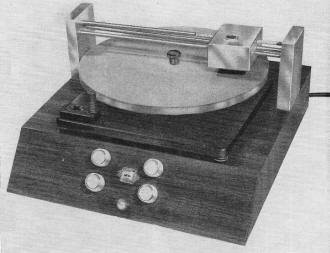
The completed 30-day record and player.
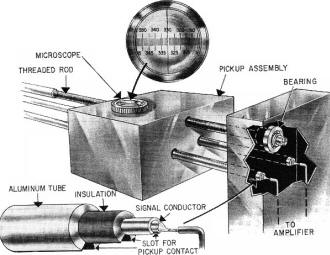
Detailed view of the pickup assembly.
 By Mohammed Ulysses Fips, I.R.E.* By Mohammed Ulysses Fips, I.R.E.*
Remarkable new technique may foreshadow end of recording as we know it today
For the editor's birthday I had planned a big surprise - the world's longest
playing record!
When flat disc records made their appearance in 1894, they ran about 2 minutes.
Then came the long-playing (LP) record in 1948. This one ran about 30 minutes
per side.
Why stop there? For years I had wondered why no one made a really long-playing
record. I decided finally that what stopped most designers was the groove system
that somebody dreamed up, probably Edison for his first cylinder record. Later,
misguided designers blindly followed the groove idea and stuck in it. Why a groove
or channel in this day and age? Must there be a stylus in a groove to wear out the
channels in due time? Silly, isn't it? Why not just a fine threaded groove on a
spindle and let the reproducer ride in it? Then make the record of a magnetic compound
similar to today's magnetic tape - but make it ALL magnetic. Now the reproducer
no longer need touch the record at all - it floats 0.0015 inch above it.
The fine threaded spindle which carries the reproducer mechanism also has a reducing
gear to suit any required time elapse. This is, of course, nothing new. The same
idea is used in certain pocket watches that give the phases of the moon, and even
the year - it's all in the watch's reducing gear wheels.
The present-day standard LP record has a groove path about 3 1/2 inches wide.
There are about 900 parallel grooves, each about 0.001 inch wide. (Length of entire
groove path: 1,411 feet or 0.267 mile.) That's about as many physical grooves as
is possible to cut in the space available.
My new 30-Day LP Record is made of cast brass for rigidity, coated with a special
iron-nickel oxide compound on a base of hard plastics. For the all-important high-polished
smoothness of the record surface, which cannot vary more than 1/10,000 inch in thickness,
several special oxides have been added to the magnetic nickel-iron layer.
Naturally, the old-style pickup with its monstrously thick needle point that
travels in a groove cannot be used with a 30-day LP record.
Something far more sophisticated is needed for my modern magnetic pickup. And
here I had to go back to the old detector days of 1914.*
For the historic Electro Importing Co. (E. I. Co.) my boss designed the famed
Radioson electrolytic detector which, incidentally, was used by the United States
Navy for several years. It used an extraordinarily fine, exposed platinum wire point
0.0001 inch (one-ten-thousandth of an inch) thick. Wollaston wire is made of platinum,
coated thickly with silver. It is drawn down till the platinum wire is only 0.0001
thick. Then the silver is dissolved with nitric acid, leaving the almost invisible
platinum wire exposed. This was far too frail to be used in a portable commercial
detector.
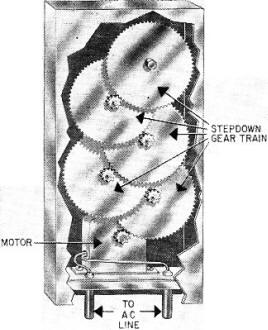
Reducing gears bring motor speed down to rotate the threaded
rod.
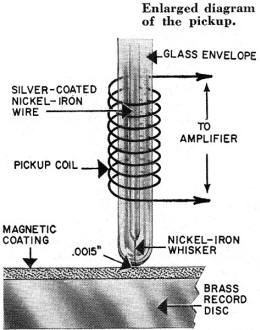
As there are no physical record grooves to contend with, we can
now make a recording of a fantastic number of phantom "grooves", in reality, paths.
Thus, instead of the mere 900 parallel physical grooves of the old LP record, we
actually have 1,152,000 magnetic paths covering 342.7 miles. (Theoretically, we
could have as many as 80,000,000 molecular- paths, a total of 23,780 miles. This
would give us an LP record running 69 months, or 5 years and 9 months!)
Here for the first time in print I disclose how the vital Radioson detector point
was manufactured.
A one-inch piece of Wollaston wire was held by its end in an alcohol burner flame
for a few seconds. That burned off the silver. Now the wire was inserted in a glass
tube and the fine, bare end of platinum was fused into the glass. When annealed,
the fused end of the glass tube was rubbed carefully over a fine-grain Carborundum
polishing stone, Under the microscope, the vital point was then inspected and repolished
till the face of a perfectly round platinum section could be seen in the microscope
field.
This was the heart of the Radioson. It was then fused into a larger glass tube
containing diluted sulphuric acid. The hermetically sealed arrangement made one
of the most sensitive radio detectors of the period.
I have chosen a very similar idea in my 30-day LP pickup (see illustrations).
Here, however, I use a magnetic pickup point. The "wire" in the sealed-off glass
tube is a variation of the recently discovered Whisker - a metallic crystal 1/20,000,000
inch thick. It is of nickel-iron coated with silver as in the regulation Wollaston
wire. The silver is removed, leaving only the nickel-iron core point that now becomes
the heart of the pickup.
The pickup travels only 0.0015 inch above the rotating record disc. The glass
tube that holds the nickel-iron wire has a special inductance winding surrounding
it, the ends of which are then connected to the amplifier. As the record revolves
below the pickup, the magnetic impulses go from the pickup wire to the high-fidelity
amplifier, exactly as in the old-time LP record, The pickup travels exceedingly
slowly across the record: it takes 30 days to traverse the distance of 3 1/2 inches
across the face of the record. The threaded spindle is turned at the proper speed
by a motor and reducing gears contained in one of the side supports.
But let us stay with my present 30-day LP record. Which brings me to the question
everyone asks: Why such a record at all?
Answer: Why have thousands of records when a few will do? Why clutter your house
with a large library of records when a few 30-day LP records will do?
My ambition - when I visualized my first 30-day record-was to construct a single
record disc, the same size as an old-style one, on which I could record ALL of Mozart's
works.
This sounds impossible if you consider all his operas, sonatas, songs, oratorios,
cantatas, concertos and symphonies - a total of over 600 works! Yet that is exactly
what I did.
I secured every Wolfgang Amadeus Mozart record I could buy or borrow and recorded
ALL of them on a single record. Unfortunately, not all of Mozart's works are recorded
on discs or tape - I fell far short of his 625 compositions. Over 50 had to be played
for me by a volunteer amateur orchestra to make the record as complete as humanly
possible. This took time - 8 months of actual recording!
Naturally you will ask who on earth will want to listen to a rendition of all
the hundreds of Mozart's works, continuously, day and night for 30 days!
Not so fast, friends. My 30-day LP record is something special, not intended
to be played uninterruptedly.
Running parallel to the spindle that carries the pickup and its gear works is
a micrometrically accurate scale numbered from 1 to 1,000. By lifting the pickup,
you can set its pointer on any number you wish.
The instruction card that lists all Mozart's works by key numbers tells you exactly
where to find each composition on the micrometric scale. Thus the complete opera
The Marriage of Figaro will be found on 189 of the scale. Set the pickup pointer
on 189, and you have the desired work. Don Giovanni will be found on 97, and so
forth.
The cost of such a record as it will be made commercially may run from $50 to
$80 - a very low price if you consider that a single record may replace several
hundred old-style LP's.
* * *
It was the editor's birthday when I presented him with the finished 30-Day LP
record. No one in the organization had had the slightest inkling of my epoch-making
invention.
The big boss seemed highly pleased, even fascinated, with it as I explained the
whole idea and its great possibilities to him. A lover of Mozart, he beamed his
pleasure as he selected the various compositions and played them at random.
But suddenly his face clouded. He bit off the end of his big cigar and threw
it down viciously. In an apoplectic rage he bellowed:
"Fips, you colossal nincompoop, you've done it again! If I ever print an account
of this insane contraption in our magazine, most of our advertisers will cancel
their contracts - we'll ruin them and they'll ruin us. Why don't you ever think
these things through, you ... you jabbering, jinxed jackass!"
With that he banged my head against something soft on the wall. As I fled out
of his office, I noted that he had slammed me against a thick, large leaf-type wall
calendar. The date read:
April 1
*Islamic Radio Engineers.
* See E. I. Co. Catalog No. 12. Also The Electrical Experimenter, January 1914,
page 144, and February 1914, page 146.
Posted April 1, 2024
These Mohammed Ulysses Fips articles appeared in Radio-Craft and later
in Radio-Electronics magazines, by in what I am sure is sheer coincidence
all appear in April issues (beginning in 1944)!
- Three-Dimensional Television - April 1965 Radio-Electronics (final appearance)
- Snorekill - April 1964 Radio-Electronics
- Teleyeglasses - April 1963 Radio-Electronics
- New - Electronic Razor - April 1962 Radio-Electronics
-
30-Day LP Record - April 1961 Radio-Electronics
- Paperthin Radio - April 1960 Radio-Electronics
- Ultra-Steered-Stereo Projector - April 1959 Radio-Electronics
- The
Transistom - April 1958 Radio-Electronics
- Lumistron - April 1957 Radio-Electronics
- The Cordless Radio Iron - April 1956 Radio-Electronics
- Silent Sound - April 1955 Radio-Electronics
- The Cosmic Generator - April 1954 Radio-Electronics
- No Article - April 1953 Radio-Electronics
- Noise Neutralizer - April 1952 Radio-Electronics
- The Hypnotron - April 1951 Radio-Electronics
- Electronic Brain Servicing - April 1950 Radio-Electronics
- Magnetic TV Enlarger - April 1949 Radio-Electronics
- Tubeless Homo-Heterodyne - April 1948 Radio-Craft
- New! Crystron Lapel
Radio - April 1947 Radio-Craft
- Now - A Radio Pen - April
1946 Radio-Craft
- Radium-Radio Receiver
- April 1944 Radio-Craft (first appearance)
|










 By Mohammed Ulysses Fips, I.R.E.*
By Mohammed Ulysses Fips, I.R.E.* 

